All You Need to Know About Blast Deflectors and Flash Cans in 2024
Posted by Charlie's Custom Clones Staff on Jun 2nd 2024
All You Need to Know About
Blast Deflectors and Flash Cans
in 2024
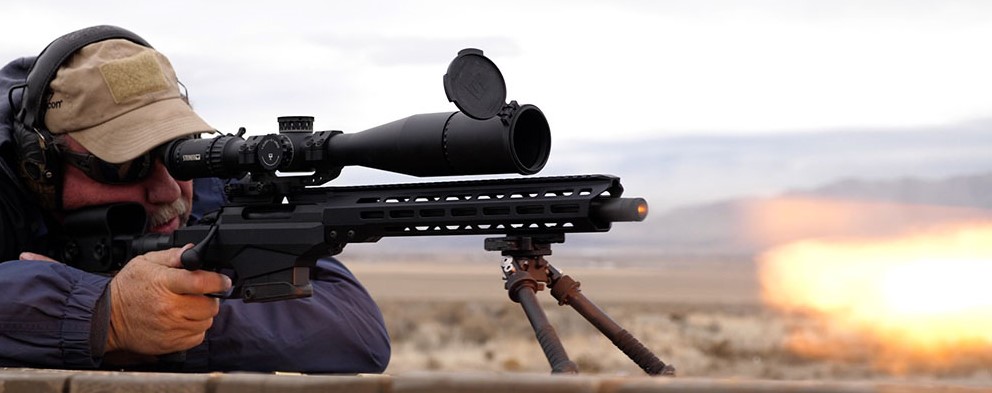
Image courtesy of David Bade and Athlon Outdoors
Protect Your Hearing and Manage Recoil: Discover Which Muzzle Device Suits You Best
Table of Contents
- Introduction
- What Are Muzzle Devices?
- Types of Muzzle Devices
- Crowned Muzzle
- Flash Hider
- Ported Muzzle Brake
- Flash Can
- Blast Diverter
- Faux Suppressors and Training Devices
- Legal Suppressors
- Comparison: Flash Cans vs. Blast Diverters
- Key Features to Look For
- Is It Just Hype?
- Benefits and Drawbacks
- Choosing the Right Device
- Installation and Maintenance
- Legal Considerations
- How Is This Different from a Fake Suppressor?
- Effectiveness and Real-World Performance
- Popular Examples
- Surefire Warden
- Griffin Dual-Lok Blast Shield
- KAK Industries Flash Can
- Noveske Pig
- History and Market Trends
- Market Trends and Innovations
- FAQs
- Conclusion
1. Introduction
As the world of firearms continues to innovate, enthusiasts and professionals alike are constantly presented with new equipment that promises improved performance and safety. Among these innovations are muzzle devices, specifically flash cans and blast diverters. While often seen as "cool" additions to a firearm, these devices serve practical purposes that are worth understanding.
The use of muzzle devices dates back to early firearm development, aiming to control recoil, flash, and noise. In warfare history, reducing muzzle flash became crucial for night combat, while competitive shooting prompted advancements for accuracy and recoil management. Today, the technology has evolved significantly, encompassing a variety of devices tailored for different shooting needs and scenarios. Innovations like the flash can have made it possible to redirect blast effectively without extensive modifications to the firearm’s design.
2. What Are Muzzle Devices?
Muzzle devices are attachments fixed to the barrel of a firearm to modify the escaping gas and the resulting noise, recoil, and flash. They come in various types and serve different purposes, from suppressing flash to minimizing recoil. Each device is designed to improve one or more aspects of shooting performance by managing the gases released upon firing.
3. Types of Muzzle Devices
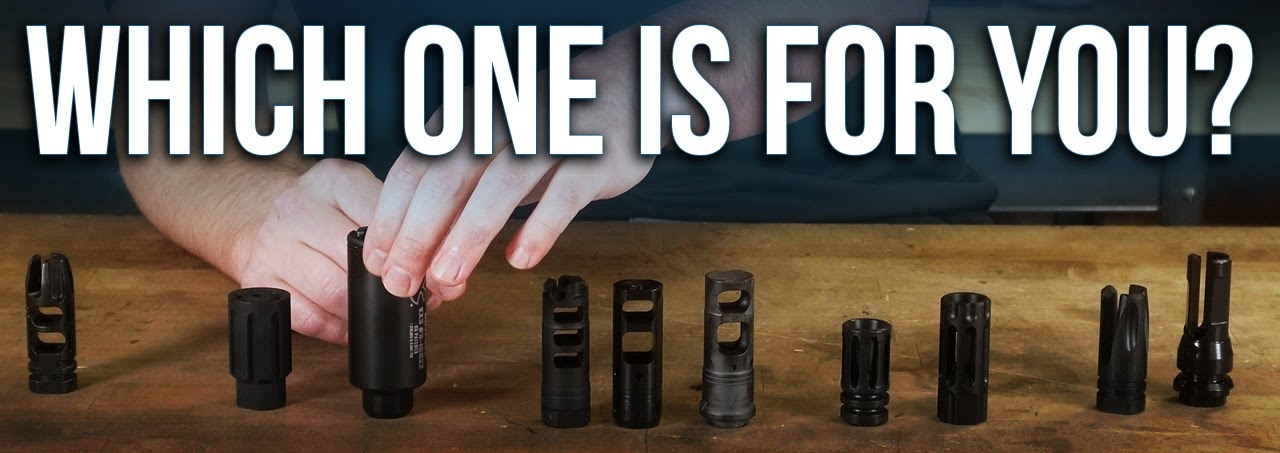
Image courtesy of Midwest Gun Works
Crowned Muzzle
A crowned muzzle is the simplest form, designed to protect the rifling and ensure accuracy without any additional effects on recoil or flash. It's the default configuration on many firearms and provides a baseline for understanding the impact of other muzzle devices. In addition to its protective benefits, the crowned muzzle is often favored by match shooters for its potential to enhance accuracy.
Flash Hider
A flash hider is a device attached to the muzzle of a firearm designed to disperse the burning gases that exit the barrel after each shot. This dispersion reduces the visible flash, which is especially useful in low-light conditions to prevent the shooter’s position from being compromised. By minimizing the muzzle flash, flash hiders also help to avoid temporary blindness that can occur from the bright light emitted during firing.
The use of flash hiders has been prevalent in military firearms for many years, but their widespread adoption on the AR platform really popularized their use. As the design of AR rifles evolved to include shorter barrels, the amount of unburned gunpowder increased, leading to larger and more noticeable fireballs. Early versions of flash hiders often featured pronged designs, which eventually evolved into the closed, bird cage style commonly seen today. This design progression has made flash hiders a ubiquitous feature on modern AR platforms.
Ported Muzzle Brake
Muzzle brakes are engineered to redirect gases to counteract recoil and muzzle rise. This allows for quicker follow-up shots by reducing the amount of force pushing the firearm backward and upward. Ported muzzle brakes, specifically, have gas ports that direct the gas laterally or upward, significantly mitigating recoil.
Flash Can
Flash cans, often called linear compensators, are built to redirect the muzzle blast forward, away from the shooter and bystanders. They are particularly popular in short-barreled firearms and pistols where the muzzle blast can be more prominent and disruptive. Flash cans help to preserve the shooter's hearing and maintain situational awareness, especially in confined spaces or indoor ranges.
Blast Diverter
Blast diverters function similarly to flash cans by directing the blast forward but focus solely on redirecting the blast without reducing the overall sound emitted. They are designed for tactical and close-quarter scenarios, enhancing the comfort and situational awareness of the shooter.
Faux Suppressors and Training Devices
These devices give the appearance of a suppressor without the regulatory requirements. They are often used for training purposes to simulate the feel and balance of a suppressed firearm. While they do not offer noise reduction, they provide valuable training experience for users planning to transition to actual suppressors in the future.
(Legal) Suppressors
Suppressors or silencers are highly regulated devices that reduce the sound of a firearm discharge. They provide significant noise reduction and can improve shooting comfort and communication in tactical scenarios. However, they require thorough legal compliance, including background checks and taxation, to own and use.
4. Comparison: Flash Cans vs. Blast Diverters
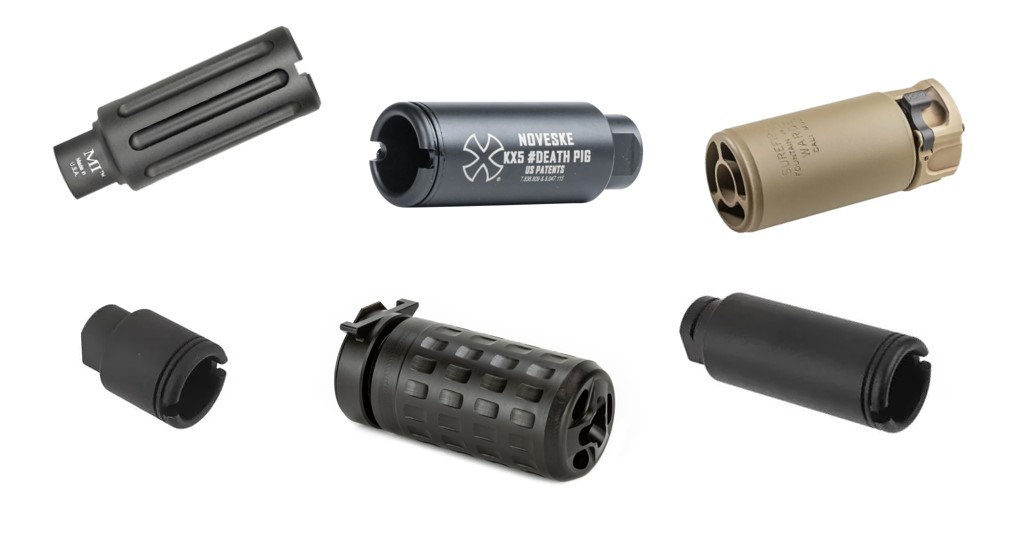
While flash cans and blast diverters share the common goal of managing muzzle blast, their designs and applications differ significantly.
- Flash Cans: Typically tubular and straightforward, these devices focus purely on redirecting the blast forward. They are simple to install and primarily benefit standard shooters looking for basic blast management.
- Blast Diverters: More complex in design, these devices not only redirect the blast but are specifically engineered to avoid reducing the overall sound emitted. They are favored in tactical applications where minimization of side blast is crucial.
5. Key Features to Look For
When choosing a flash can or blast diverter, several essential features can help you make the best decision for your needs.
Material:
The material of a muzzle device significantly impacts its durability. High-quality flash cans and blast diverters are typically made from stainless steel or aluminum, which can withstand sustained use and high temperatures.
Finish:
A good finish not only enhances the look of the muzzle device but also protects it from corrosion. Look for corrosion-resistant coatings like nitride or Cerakote, which offer excellent wear protection and longevity.
Compatibility:
Ensure the device fits your firearm’s barrel specifications. This includes the threading, which needs to match the barrel for a secure fit. Some devices are designed for specific calibers and barrel lengths, so verify compatibility before purchase.
Performance:
Real-world performance is crucial. Check reviews and performance testimonials to understand how a particular model performs during extended use. Factors like blast direction, noise reduction, and ease of installation contribute to overall performance.
Ease of Installation:
Some muzzle devices require specialized tools for installation. If you prefer a straightforward setup, look for models designed for easy installation without the need for professional gunsmithing.
6. Is It Just Hype?
There are many shooters who believe that devices like flash cans and blast diverters are merely about the "cool" factor or looking like suppressors. However, these devices serve practical functions that extend beyond aesthetics.
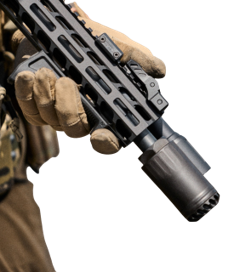
Practical Functions:
Flash cans and blast diverters offer tangible improvements in shooting comfort by redirecting the muzzle blast away from the shooter and bystanders. This can be particularly beneficial in confined spaces or indoor shooting ranges.
Tactical Advantages:
In tactical scenarios, minimizing side blast can enhance communication and coordination among team members. Additionally, directing the blast forward can preserve situational awareness and reduce the concussive effect felt by the shooter.
Enhanced Shooting Experience:
For competitive and recreational shooters, these devices can make shooting more enjoyable and less fatiguing, especially when firing high-caliber or short-barreled firearms.
While the visual appeal of these devices cannot be denied, and, there are clearly some users who adopt a flash can or blast deflector for the cool factor, their practical benefits make them valuable additions to many shooters' arsenals. Understanding their true function helps dispel the notion that they are purely for show.
7. Benefits and Drawbacks
Understanding the benefits and drawbacks of flash cans and blast diverters can help determine which device suits your specific requirements.

Benefits:
- Reduced Side Blast: Both flash cans and blast diverters significantly reduce the blast felt by those adjacent to the shooter. This can make your shooting environment more comfortable, especially in close-quarters scenarios or with multiple shooters.
- Enhanced Shooter Comfort: By directing the muzzle blast forward, these devices can make shooting more comfortable and manageable. They mitigate the concussive blast felt by the shooter, which is particularly beneficial when firing high-caliber or short-barreled firearms.
- Improved Tactical Communication: Less side blast can help maintain better communication in tactical situations, where team coordination and clear communication are critical.
- Hearing Protection: For shooters who frequently train or operate in confined spaces, these devices can help preserve hearing by directing the sound and pressure wave away from the shooter.
Drawbacks:
- Weight Addition: Some devices can add noticeable weight to the firearm, potentially affecting balance and handling. This is particularly relevant for shooters who need to carry their firearms for extended periods.
- Length Increase: Extending the length of the barrel, especially with short-barreled rifles, can affect maneuverability and make the firearm more cumbersome to handle in tight spaces.
- Cost: High-quality devices can be expensive, and there may be additional costs for installation or adapters. Budget options are available, but they may not offer the same level of performance or durability as premium models.
8. Choosing the Right Device
Selecting the right muzzle device involves assessing your specific needs and preferences. For general shooting comfort, a simple flash can may suffice. For tactical operations where side blast minimization is crucial, consider a more sophisticated blast diverter.
Determine whether you need the device for general shooting, competitive shooting, or tactical scenarios. Each purpose may prioritize different features, such as noise reduction, blast direction, or ease of installation.
Consider the type of firearm you’re using. Short-barreled rifles and pistols may benefit more from blast diverters, while standard rifles and carbines might find flash cans more effective.
Ensure that the device complies with local laws and regulations. Some jurisdictions have specific restrictions on muzzle devices, and violating these laws can result in severe penalties.
9. Installation and Maintenance
Most flash cans and blast diverters screw directly onto the barrel, but it's vital to follow manufacturer instructions carefully to ensure proper installation.
Installation Tips:
- Use the appropriate tools, such as a barrel vise and the correct wrench, to avoid damaging the device or the firearm.
- Apply a suitable thread locker to prevent the device from loosening during use, especially under rapid-fire conditions.
Maintenance:
- Regular cleaning and inspection are essential to maximize performance and lifespan. Carbon build-up can affect the efficiency of the device, so ensure it’s cleaned periodically with appropriate solvents and brushes.
- Check for wear and tear, such as baffle erosion or surface scratches, and replace the device if significant damage is noticed.
10. Legal Considerations
While flash cans and blast diverters are generally less regulated than suppressors, it’s crucial to always check local, state, and federal laws. Some regions have specific restrictions on muzzle device modifications.
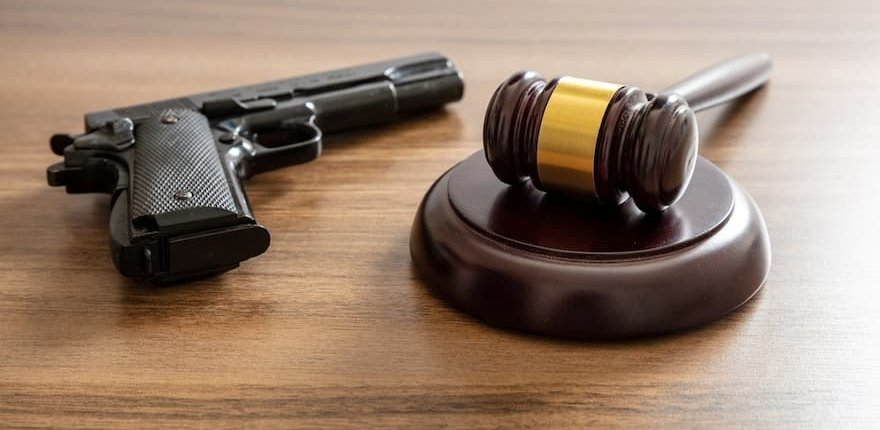
- Federal Regulations: The ATF does not classify flash cans or blast diverters as suppressors, so they do not require the same rigorous process for ownership. However, always double-check for any updates or changes in regulations. This assumes that the device does not reduce the overall sound emitted from the firearm. Many manufacturers will submit their devices to the ATF for testing to assure that no sound is reduced.
- State and Local Laws: Some states have specific bans on certain types of muzzle devices. Always verify that your selected device is legal in your jurisdiction to avoid potential legal issues.
- International Considerations: In many countries outside the United States, the regulations surrounding muzzle devices can be even more stringent. Shooters must ensure they comply with international, national, and local laws to avoid severe legal consequences.
11. How Is This Different from a Fake Suppressor?
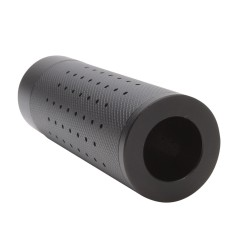
Faux suppressors and training devices are designed to replicate the look and feel of a real suppressor without the regulatory hurdles. However, they serve different purposes compared to flash cans and blast diverters.
Faux suppressors are often used in training environments to simulate the added weight and balance of a suppressed firearm. This helps soldiers and law enforcement officers train effectively without needing actual suppressors. They do not offer any noise reduction but provide realistic practice conditions that mimic real-world scenarios.
Similar to flash cans, these devices redirect the muzzle blast forward without reducing overall sound. They provide a semblance of suppressed firing to aid in training without the associated hassle of suppressor regulations.
Because they do not function as actual suppressors, faux suppressors are often legal in jurisdictions where real suppressors are heavily regulated or banned. This makes them a popular choice for shooters in such areas.
Understanding these differences highlights the unique benefits of each device type and clarifies their respective roles in shooting and training environments.
12. Effectiveness and Real-World Performance
Understanding the effectiveness of these devices relies on both technical specifications and user experiences. Both flash cans and blast diverters are designed to direct the muzzle blast forward, which has several practical implications.
Field Testing:
- Field tests often reveal how these devices perform under various conditions, including rapid firing, prolonged use, and exposure to different environmental factors. Shooters generally find flash cans and blast diverters effective in mitigating side blast and improving comfort.
Practical Scenarios:
- In close-quarters combat or confined spaces, the forward-directional design of blast diverters and flash cans minimizes the concussive effect on the shooter and nearby team members. This can be crucial in maintaining operational effectiveness.
- In recreational shooting environments or competitive scenarios, these devices can make extended shooting sessions less fatiguing and more enjoyable.
Overall, the real-world performance of these devices consistently aligns with their intended purposes, offering tangible benefits that enhance the shooting experience.
13. Popular Examples
In this section, we take a deep dive into some of the most popular examples of blast deflectors and flash cans available on the market.
Surefire Warden

The Surefire Warden is a blast deflector designed to redirect blast and concussion forward, preserving the shooter’s comfort and situational awareness. Constructed from robust stainless steel, it features a durable Cerakote finish that provides excellent resistance to wear and corrosion. The Warden uses the Surefire SOCOM muzzle device, allowing for a quick-attach mechanism that is both secure and easy to operate.
Key Features:
- Quick-attach mechanism compatible with Surefire’s muzzle devices.
- Durable construction with a corrosion-resistant finish.
- Efficient at reducing side blast and concussion.
User Feedback:
Users appreciate the Warden for its solid build and effective blast management. It is particularly favored by tactical shooters and professional operators who require reliable performance in various environments.
Griffin Dual-Lok Blast Shield
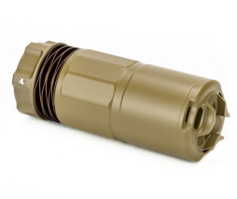
The Griffin Dual-Lok Blast Shield is a well-engineered blast diverter known for its innovative quick-detach mechanism. Made from 17-4 stainless steel, it promises both durability and high performance. The Dual-Lok system ensures a secure lockup between the blast shield and the muzzle device, effectively mitigating side blast and enhancing shooter comfort.
Key Features:
- Quick-detach mechanism for fast installation and removal.
- High-strength stainless steel construction.
- Effective side blast reduction.
User Feedback:
Users highlight the Dual-Lok’s ease of use and robust performance. The ability to quickly attach and detach the device makes it ideal for dynamic shooting scenarios where adaptability is key.
HUXWRX Blasphemy Blast Deflector
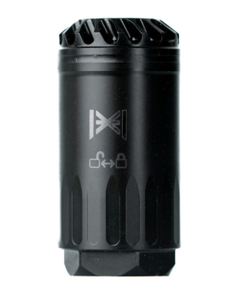
The HUXWRX Blasphemy is a blast deflector engineered to mitigate the side blast and concussion from shooting activities. It is made from high-strength steel with a resilient Cerakote finish. The Blasphemy integrates seamlessly with HUXWRX muzzle devices, utilizing a quick-mount system for easy operation and secure attachment.
Key Features:
- Quick-mount system compatible with HUXWRX muzzle devices.
- High-strength steel construction with a robust Cerakote finish.
- Efficiently redirects blast and concussion forward.
User Feedback: Users commend the HUXWRX Blasphemy for its robust construction and superior blast management. Tactical shooters and professional operators highlight its reliability and seamless integration with other HUXWRX products, noting its effectiveness in maintaining comfort and situational awareness in various conditions.
KAK Industries Flash Can
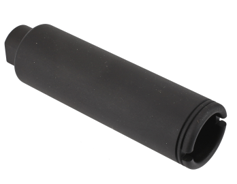
The KAK Industries Flash Can is a simple yet effective linear compensator designed to direct muzzle blast forward. Made from high-quality aluminum with a black anodized finish, it is a budget-friendly option without compromising on performance. Its straightforward design allows for easy installation, making it accessible for shooters of all skill levels.
Key Features:
- Lightweight aluminum construction.
- Cost-effective option with reliable performance.
- Easy installation process.
User Feedback:
Users appreciate the Flash Can for its affordability and effectiveness in redirecting the muzzle blast. It’s often recommended for casual shooters and those looking for a cost-effective upgrade.
Noveske Pig
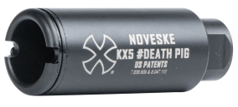
The Noveske Pig is a linear compensator known for its distinctive design and robust construction. Made from heat-treated steel, the Pig is designed to withstand high temperatures and prolonged use. Its unique shape not only adds a tactical aesthetic but also contributes to its efficiency in managing muzzle blast.
Key Features:
- Heat-treated steel construction for maximum durability.
- Distinctive design that enhances performance.
- Effective forward blast redirection.
User Feedback:
Users commend the Noveske Pig for its durability and performance. The unique design serves both functional and aesthetic purposes, making it a popular choice among enthusiasts who value both form and function.
14. History and Market Trends
The market for muzzle devices has seen significant evolution over the years, with early examples of blast deflectors and flash cans setting the stage for modern designs.
Early Innovations:
Initial muzzle devices were developed to address the needs of military forces seeking to reduce flash and manage recoil in the field. Early blast deflectors were rudimentary but effective in improving shooter comfort and reducing the revealing muzzle flash in low-light conditions.
Development Over the Decades:
The 1970s and 1980s saw significant advancements in muzzle device technology, driven by the needs of both military and civilian shooters. Improvements in materials and manufacturing processes allowed for more durable and effective blast management solutions.
By the 1990s, the market expanded to include a variety of designs, catering to different shooting disciplines, from tactical applications to competitive shooting.
Modern Trends:
Today, the market continues to innovate with new materials and designs focused on enhancing performance and comfort. Lightweight alloys and advanced finishes have become standard, ensuring devices remain durable yet lightweight.
There is a growing trend towards multi-functional muzzle devices that combine features of flash hiders, muzzle brakes, and blast deflectors, providing versatile solutions for shooters.
Future Outlook:
The future of muzzle devices will likely see continued integration of advanced materials such as titanium and engineered polymers, which offer even greater strength-to-weight ratios.
Advancements in 3D printing technology are also expected to play a role, allowing for highly customized and precise designs that can be produced quickly and cost-effectively.
Regulatory landscapes may impact future trends, particularly as legislation evolves in response to advances in firearm technology.
15. Market Trends and Innovations
Continuing from the historical perspective, it is essential to explore the current and emerging trends shaping the market for muzzle devices.
Material Advancements:
The use of titanium and other high-strength alloys continues to grow, providing stronger and lighter solutions. These materials offer exceptional durability without significantly increasing the firearm's weight, making them ideal for both tactical and recreational use.
Design Efficiency:
Compact and efficient designs that do not compromise performance are becoming more popular. Engineers are focused on minimizing the length and weight of muzzle devices while ensuring they effectively manage muzzle blast and recoil.
Multi-Functionality:
Some modern muzzle devices are designed to perform multiple functions, such as reducing flash, managing recoil, and redirecting blast simultaneously. This multi-functionality is particularly appealing to shooters who want a single device that can meet various needs.
3D Printing and Customization:
Advances in 3D printing are allowing for more customized and intricate designs. This technology enables the production of muzzle devices tailored to specific performance criteria and shooter preferences.
Regulatory Impact:
Evolving firearm regulations may influence the design and availability of muzzle devices. Manufacturers are staying ahead by developing products that comply with current and anticipated laws while still delivering high performance.
16. FAQs

To provide comprehensive information, here’s a list of commonly asked questions and detailed answers:
- QUESTION: Do flash cans reduce recoil?
ANSWER: Flash cans mainly redirect the blast forward and have minimal impact on recoil. Their primary function is to manage muzzle blast.
- QUESTION: Can I use flash cans indoors?
ANSWER: Yes, redirecting the blast forward can make indoor shooting more comfortable and reduce the concussive effect on the shooter and nearby individuals. Or, use a blast deflected wherever you damn well please !
- QUESTION: Are these devices legal everywhere?
ANSWER: The answer is: They damn well should be! While generally less regulated, always verify against local laws. Some jurisdictions may have specific restrictions on certain muzzle devices.
- QUESTION: How often should I clean my muzzle device?
It’s advisable to clean the muzzle device after every shooting session to prevent carbon build-up, which can affect performance. Blah, blah, blah... Charlie never cleans his flash can, just throws it on the rifle with the happy switch, and shit burns off. haha.
- QUESTION: Are there multi-function muzzle devices?
ANSWER: Yes, some modern designs combine the features of flash hiders and blast diverters, offering versatile performance for various shooting needs. But, you knew that was the answer, right?
- QUESTION: Will a muzzle device affect my firearm's accuracy?
ANSWER: Properly installed muzzle devices should not negatively impact accuracy; some, like crowned muzzles, can even enhance it. Always follow manufacturer guidelines for installation. Then again, some of us need an excuse for our 3 MOA shots, like golf, so blame the device.
- QUESTION: Do blast diverters reduce noise?
ANSWER: No, blast diverters do not reduce the overall sound emitted by the firearm; they only redirect the blast forward. To be exempt from federal regulation, they must not reduce the sound levels.
- QUESTION: Can I install a muzzle device myself?
ANSWER: YHell yeah! You can do anything, brother. And, many muzzle devices are designed for easy installation. However, if you are unsure, it is best to have a professional handle the installation to ensure it is done correctly. Or, if you have been drinking, it is not advisable to thread anything on your barrel.
- QUESTION: Why would I choose a muzzle device over a suppressor?
ANSWER: Muzzle devices like flash cans and blast diverters can be simpler to acquire and use given the stringent regulations around suppressors. They provide effective blast management without the legal and financial hurdles of suppressors. Or, maybe you live in a state with lame law makers who somehow think it is okay to usurp their authority and take away your God given natural right to own a suppressor.
- QUESTION: What are the common use cases for flash cans and blast diverters?
ANSWER: Flash cans are popular for short-barreled rifles and AR pistols, while blast diverters are often used in tactical scenarios and by shooters in confined spaces.
17. Chuck's Final Thoughts
Understanding the functionality and benefits of flash cans and blast diverters is essential for any firearm enthusiast or professional. These devices provide practical solutions for managing blast and improving shooting comfort, rather than just being about aesthetics.
Some of the popular choices for the blast diverter are the Surefire Warden and the Griffin Dual-Lok Blast Shield. The Warden tends to be favored by tactical shooters, and the Griffin is a general-purpose product offering with a similar QD locking mechanism.
The KAK Flash Can and the Noveske Pig are both flash cans and made for the commercial shooter. The KAK device is made from aluminum and is very affordable, while the Noveske product is a two-part steel device for shooting enthusiasts looking for added performance and name brand.
Whether you're a professional, a recreational shooter, or someone involved in tactical operations, choosing the right muzzle device can enhance your shooting experience. By understanding the practical benefits and selecting a device that suits your needs, you can better manage muzzle blast, improve shooting comfort, and stay ahead of the curve with the latest innovations in firearms technology.
As always, the team at Charlie's stands ready to help you with world clase knowledge in tactical accessories, and great equipment for your rifle.

